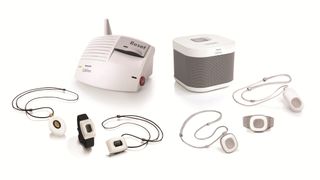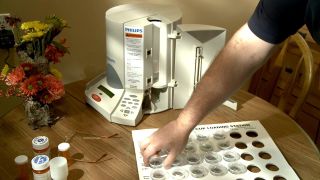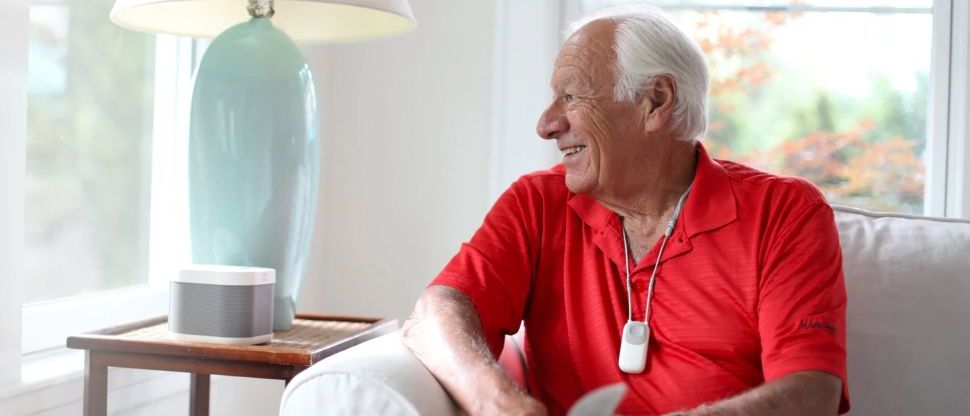Welcome to our comprehensive review of the Philips Lifeline medical alert system. If you're thinking about purchasing a medical alert system, you'll want to make an informed decision. We've done hours of research and tested the best systems to create our guide to the best medical alert systems around.
Philips Lifeline: What you need to know
Lifeline was the first medical alert system available in the United States and was purchased by Philips a long time ago. Over the years, the product has evolved, providing both in-home and out-of-home protection, with some stylish and lightweight wearables.
The company also has a unique medication dispenser, which not only reminds a senior that it’s time to take their medication but also dispenses the right medication, making it easier to manage and control even complicated routines.
Comparatively high costs and activation fees make this a premium service that won’t necessarily be right for all.
Packages: How much does Philips Lifeline cost?

Philips Lifeline covers protection both inside and outside the home, but it’s important to buy the model that best fits your needs at the point of sale. Here, we’re looking at the options that are available and how they stack up.
It’s worth pointing out that Philips offers professional installation for $99 for its systems, which may be helpful if you want to ensure that the system is installed and working properly. If you go for self-installation, there’s still a $19.95 charge on many of the systems, which seems a bit cheeky.
HomeSafe Standard
HomeSafe Standard is the basic model that protects you inside your home. It comes with a base station that connects via landline to the HomeSafe monitoring center. Prices start at $29.95 per month, although there’s a cellular option that works on AT&T’s network for $43.95 a month. There’s also a one-time activation cost of $50.
Prices here are a little higher than the competition, with Bay Alarm Medical offering a cheaper landline option and MobileHelp having cheaper cellular options.
Each system comes with a single water-resistant help button, which can be a Pendant or a Wristband. Optionally, you can choose to get a Voice Extension box, which lets you put a second communicator where you need it. For those with larger homes, this could be exceptionally useful, or you can simply have two communicators in the most commonly used rooms, such as bedroom and living room. There’s also an optional Key Lockbox, which costs $29.95.
There’s no option for wall-mounted buttons, which may put some people off that want extra cover around the home. Battery backup provides a continued service for up to 30 hours.
HomeSafe with AutoAlert
If you want fall detection, you need HomeSafe with AutoAlert. This gets you the same landline-based base station as with the standard HomeSafe package, but ships with the water-resistant fall detection pendant.
The cost is higher here, starting at $44.95 for the landline version, and jumping to $58.95 for the cellular model. That’s $15 more for the fall detection cost, far higher than the industry-standard $10 a month. In addition, there’s a one-time $50 activation fee for this package. You get the Voice Extension and Lockbox options as with the standard system.
GoSafe 2
If you want mobile-only cover, the GoSafe 2 is the pendant for you. This single device contains everything you need, including integrated AT&T cellular, two-way communication, and fall detection alongside the alert button.
There’s built-in GPS to tell emergency services where you are, which works with WiFi to better improve the result. As well as this, there are intelligent location breadcrumbs, which track your position to help determine your location in the event that there’s no GPS fix. And, there’s the Audio Beacon, which is a loud siren to help guide help to your exact location.
Relatively stylish, as these things go, the GoSafe 2 is considerably slimmer than much of the competition. It has a rechargeable battery that lasts for two to three days, and you can plug in the charger while you’re wearing it. Effectively, you shouldn’t have to remove the device and it can even be worn in the shower.
It costs $49.95, plus there’s a one-time $99.95 device fee, which makes this one of the most expensive mobile medical devices. As a comparison, the GreatCall Lively Mobile is considerably cheaper.
There’s no companion app or location tracking for this device, either, so if tracking a loved one’s location is important, you’ll want to look elsewhere. The only additional option is the Key Lockbox for $29.95.
GoSafe
Although it's the older product, the GoSafe is a combined in-home and out-of-home device. At home the supplied pendant communicates with the base station for making calls to the monitoring center. When you go outside, the pendant switches to use its cellular connection, giving protection everywhere else, and you can use it to make a two-way call. As well as push-button alerts, the pendant has built-in fall detection, too.
Outside, the GoSafe uses GPS and Wi-Fi enhanced locating to determine your position, and it has an audio beacon: a siren that can guide emergency response to your exact location.
Due to its dual methods of connecting, the GoSafe pendant has a battery that should last up to seven days on a charge, and it can be charged while being worn. As the pendant is waterproof it can even be worn in the shower or bath, so there’s no need to remove it. There’s still no app to keep tabs on a loved one’s location, though.
For the home system, there’s a choice of landline connection ($54.95 a month) or cellular ($69.95 a month). Both packages have a one-time device fee of $149.
Philips Medication Dispenser

For $59.95 a month (plus a fixed $99 installation fee), the Philips Medication Dispenser is there to make sure that the right doses are taken at the right time. It consists of a machine that is loaded with up to 60 cups of medicine, each filled with the right dose. The Medication Dispenser can be set to send out up to six doses per day according to the schedule you set.
This is a step up from a medicine reminder service, where the correct doses still have to be measured out before being taken. It’s all backed with an 18-hour battery, so a power cut won’t prevent medicines from being taken. Alerts are sent for missed doses, dispenser errors, and refills.
The Medication Dispenser doesn’t have be rented with a Philips Lifeline medical alert system, so it’s possible to use this as an add-on for any other medical alert system.
Philips Lifeline: Warranty and Cancellation
Free cancellation: 30 days
System price (starts at): $69.95
Monthly costs (starts at): $29.95
In-home monitoring: Yes
Outside monitoring: Yes
Philips offers a generous 30-day return period on any order, giving you a cool-off period to return products without charge. All products have to be returned in an ‘as new’ condition, including all instructions and cables, otherwise there may be a restocking charge of up to $75. Services can be cancelled at any time, although you have to pay for the full month of service that you cancel in.
All devices are covered by a one-year limited warranty, which covers faulty products but not accidental damage or loss.
There’s no charge for moving address, although you may need to pay for professional installation again if you want this service. It’s important to let Philips Lifeline know your new details so that they can send help to the right location. Details of your Lockbox can be provided to gain entry to your home, and we recommend having any important medical details placed somewhere easy for responders to find.
How does Philips Lifeline deal with an alert?

Alerts can be triggered by pressing an alert button or when a fall is detected automatically. Both types of alert trigger a call to go through, either through the base station for in-home systems or via the pendant for mobile systems.
Once connected, the call center accesses your personal profile and response plan, which shows who’s on your contact list, including friends and family, and your preferred emergency provider. After discussing the options, the team can dispatch the right medical help to your location, using either your address or the GPS details on your device. In the event that you can’t respond or the team can’t hear you, emergency help can be dispatched automatically.
Philips Lifeline: What the users say
We’ve used both our impressions of the product and user reviews from trusted sources to get a full overview of how Philips Lifeline works. When we originally tested, the product performed well, with excellent range meaning our help buttons worked everywhere in our home.
Those users that have the service are impressed with it, with the company scoring 4.6 on Consumer Affairs. Positive reviews describe the reliability of the service, the quick response times and the quality of the monitoring service. There are a few complaints about false alerts, but nothing out of the ordinary compared with the competition.
Philips Lifeline: Verdict
Philips Lifeline is a high-quality and simple system to use, delivering protection inside and outside the home. The system is reported as being reliable, and the monitoring center deals well with emergencies.
The main issues that we have are the high equipment costs, installation fees and higher-than-average monthly fees. If you’re after better-value products, then GreatCall Lively Mobile is far cheaper for on-the-go protection, while Bay Alarm Medical and MobileHelp have cheaper in-home systems.
Philips Lifeline also falls short when it comes to extras, with no location tracking or wall-mounted buttons as options. If you want more than just basic alerts, then look for a system such as Medical Guardian, which has a sensor-based tracking system to keep an eye on a loved-one’s activity.

